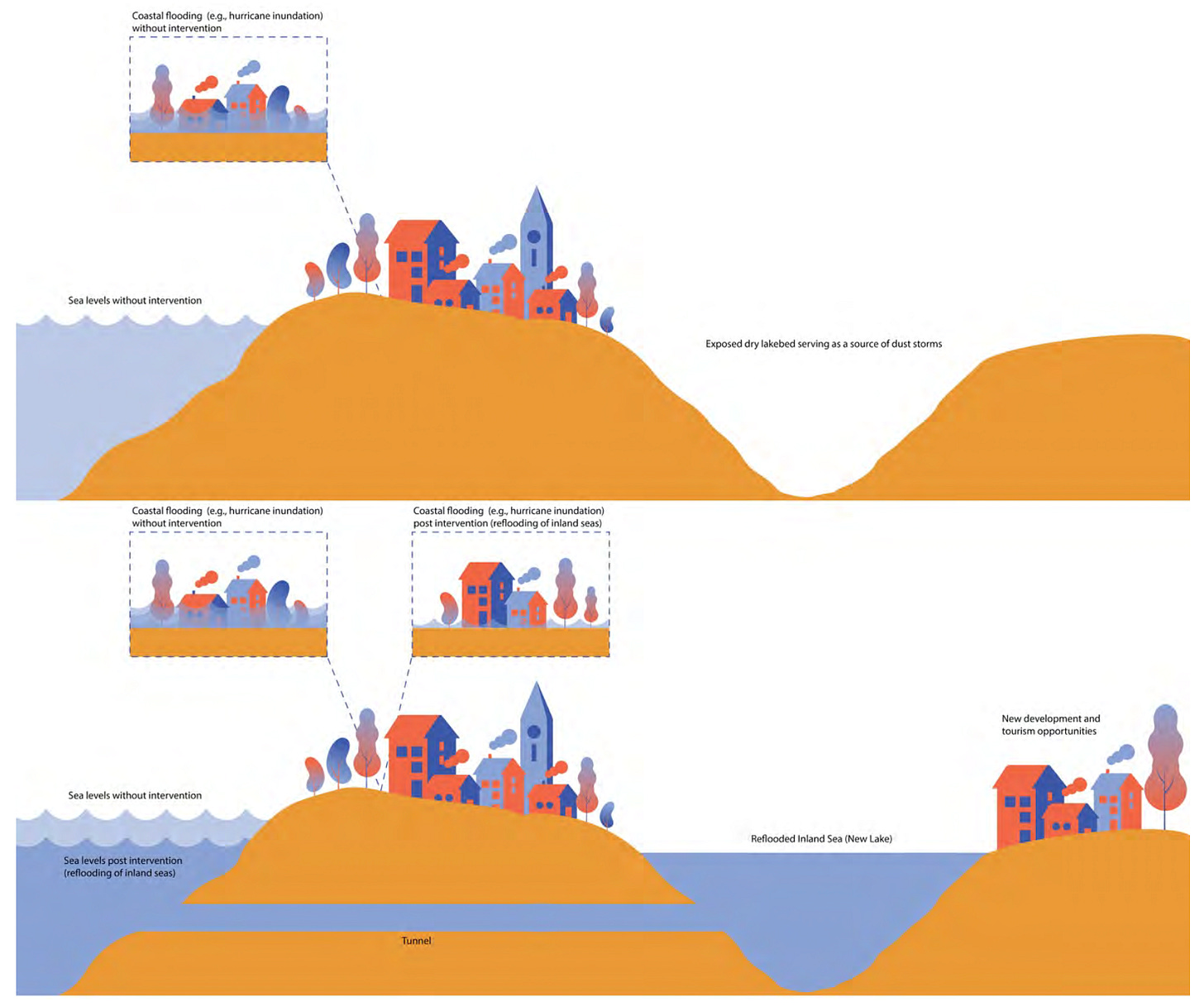A note from the ARC team: This blog is part of a series of ambitious ideas to address catastrophic climate risks we’re publishing in the runup to New York Climate Week – check out our first article, and if you’ll be at NYCW, let us know!
Today, we’re excited to publish a new ARC report from our Coastal Futures Resilience Initiative (CFRI) on an innovative strategy for addressing sea level rise while building a more resilient future: reflooding inland seas.
Today, the seas are rising faster than ever recorded in human history. Sea level rise projections are highly uncertain and have been rising (and accelerating) faster than predicted. Conventional consensus is an expectation of about 0.5 additional meters of SLR by the end of the century, and 1 to 2 meters is very much possible, particularly if ice sheets continue to degrade more rapidly than predicted. Impacts of SLR are already mounting every year as storms intensify and floodplains grow larger. The total global cost of sea level rise could surpass $14 trillion annually by 2100 under high-emissions scenarios, with some nations losing up to 10% of their GDP, as flooding, land loss, and infrastructure damage ripple through economies and livelihoods (and note, this is just first-order economic impacts). Even just another 11 cm difference in sea level could add over $1 trillion per year in damages. This would be economically (and indeed socially) catastrophic, roughly at the level of the Great Depression, except these losses would be chronic and compounding, hitting year after year as seas rise.
For decades now, big infrastructure responses to the increasingly inexorable rise of the oceans have mostly meant walls, pumps, or managed retreat. But what if part of the answer lies in geography itself, in vast natural basins that once held seas or lakes, sitting tens to hundreds of meters below today’s ocean level? These places are, in a sense, empty vessels. With the right engineering, they could act as giant reservoirs, giving us room to store water that otherwise raises global sea levels centimeter by centimeter.
The idea sounds bold – even a little crazy, we’ll grant – but it’s grounded in solid geoscience. CFRI’s new report is the first global survey to pull these sites into one frame and ask: could they help buy us time against the rising ocean? From Egypt’s Qattara Depression to California’s Salton Sea, from Lake Eyre in Australia to the Dead Sea, these depressions represent real opportunities to offset global sea level rise (in some cases, quite substantially) while also creating new economic, energy, and ecological benefits – though, as we note in the report, each site involves their own unique geopolitical and local community considerations to ensure equity and legitimacy.
So … Why Inland Seas?
Global sea levels are rising faster than expected, threatening homes, economies, and entire nations. By 2100, unchecked sea level rise could cost the world over $14 trillion a year and force millions from their homes. Traditional adaptation measures to create more resilient coasts will remain crucial, but they are simply (very) unlikely to be enough on their own, particularly in poorer countries.
The CFRI report looks at inland depressions – i.e. basins that sit below sea level, many of them remnants of ancient saline lakes or seas – as potential “release valves” for rising oceans. If these basins were refilled with seawater, they could offset global sea levels by centimeters at a time. That may not sound like much, but each centimeter matters: A 20 cm reduction in global sea levels would not just protect the 23 million people who would otherwise be permanently inundated, it would also greatly reduce exposure for hundreds of millions more and prevent billions in damages for communities who face worsening storm surge, compound flooding, and extreme weather events along low-lying coastal zones, where each centimeter of sea level translates into kilometers of inland floodplain. 20 cm may sound small, but it represents $3.3 trillion in assets and 66,000 square kilometers of coastal land. Moreover, since many of these sites were saline lakes or under seawater in the past, the surrounding environments are not unfamiliar with the presence of seawater, which could ease ecological adaptation compared to entirely new inundations.
Coastal Futures Resilience Initiative Report
Beyond Risk Reduction
Reflooding projects are not just about storing seawater. They come with a range of co-benefits:
Energy: New hydropower and geothermal opportunities, plus potential for floating solar.
Economies: Job creation, urban development, tourism, aquaculture, and increased land values.
Ecosystems: New wetlands, potential cooling effects in hyper-arid zones, and even weather pattern shifts.
In other words, these projects could reduce global flood risk while creating new sources of economic growth and ecological resilience.
Where Could This Work?
The CFRI team, led by ARC Fellow Amir AghaKouchak, started with NASA topography data and mapped more than a dozen candidate basins worldwide. The report highlights several promising sites:
Qattara Depression (Egypt): Comparable in volume to Lake Ontario. This one could slow global sea level rise by ~2 cm at a cost on par with New Orleans’ post-Katrina levees, less than half of the cost of China’s Three Gorges Dam, or the world’s 25 most expensive yachts.
Lake Eyre / Kati Thanda (Australia): Three times the capacity of Qattara, with a whopping potential 7 cm sea level offset. We note that partnership with indigenous communities would be essential here.
Danakil Depression (Ethiopia/Eritrea): Quite literally one of the hottest places on Earth, and geologically ideal. Strong cost-benefit ratio with added geothermal power potential. Geopolitical tensions would need to be thoughtfully considered.
Caspian Sea: Gigantic capacity, seven times Qattara’s potential, though politically complex, as we discuss in the report.
Dead Sea (Israel/Jordan) and Salton Sea (California, USA): Already shrinking rapidly, creating ecological and public health crises. Reflooding could restore ecosystems while reducing toxic dust and generating economic opportunities, though we recognize geopolitical complexity here as well.
To be clear, these are ambitious infrastructure concepts, and not all of them will prove possible. Some sites cross national boundaries and bring real geopolitical complexity, like the Dead Sea. Others have already seen development pressures, such as summer homes on exposed land around the Caspian. In places like Lake Eyre / Kati Thanda in Australia, Indigenous rights and co-management with the Arabana people must be an absolute priority, with equitable climate action defined by partnership rather than imposition. At the same time, several basins, including Qattara in western Egypt, appear to have no fundamental barriers and may represent rare opportunities for large-scale, high-leverage climate infrastructure. Future phases of this work will require careful, place-specific engagement with local communities, governments, and stakeholders to ensure any project is co-developed responsibly and legitimately.
(See the report for detailed charts on projected costs, offsets, and ROI estimates.)
A Moonshot Worth Exploring
No one is saying these projects should break ground tomorrow. They are massive undertakings with meaningful potential trade-offs for ecological disruption, displacement, or cultural heritage. However, as we’ve discussed before, we must practice the habit of comparing the risks of such projects to the price of inaction, which will almost certainly be higher and far more catastrophic on all such accounts. What’s more, the early numbers in the report findings suggest they could deliver local benefits that greatly surpass the initial costs, and global returns that would dwarf those costs and function as a public good for humanity, helping to protect countless places and communities that would otherwise disappear to rising seas and more deadly storms. Compared to reducing emissions alone (which is essential to slow the pace of warming but likely cannot stop ice sheet collapse already underway), reflooding addresses the water problem directly.
CFRI’s analysis suggests that targeted reflooding could be 30 times more cost-effective per centimeter of sea level reduction than carbon mitigation alone. It’s critical to underscore that this is not a replacement, but a promising complementary strategy, one which can make humanity safer and more prosperous.
What’s Next
This report is the first comprehensive survey of its kind. It doesn’t claim to have all the answers, but it lays the groundwork for the feasibility studies, environmental assessments, and international conversations needed to decide if, when, and where inland reflooding might make sense.
ARC is excited to continue supporting this project, an example of the kind of translational research we founded the ARC fund to support: advancing ambitious, under-explored ideas that can meaningfully address the catastrophic climate risks we now face, and making sure that if (or when) the world needs new options, we aren’t starting from scratch.
We’re thrilled to share this work with you and would welcome ideas for how to move this conversation forward.
Read the full report.
About the Report Author
Amir AghaKouchak is a Professor of Civil and Environmental Engineering and Earth System Science at the University of California, Irvine. He is the Lead for Water, Climate and Infrastructure Risk at the United Nations University-Institute for Water Environment and Health (UNU-INWEH). His research focuses on natural hazards and climate extremes and crosses the boundaries between hydrology, climatology, and remote sensing. Amir has published 260 peer-reviewed research articles in scientific journals. He has received several honors and awards including the American Geophysical Union’s James B. Macelwane Medal, Fellow of AGU, and the American Society of Civil Engineers (ASCE), Norman Medal and ASCE Huber Research Prize.




